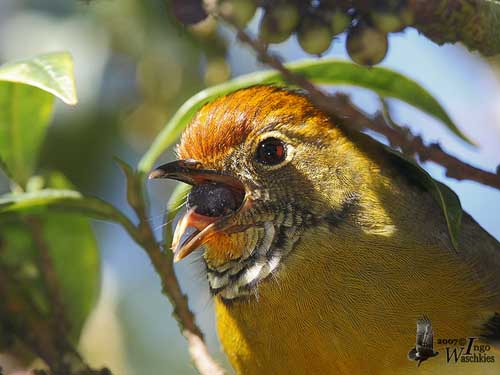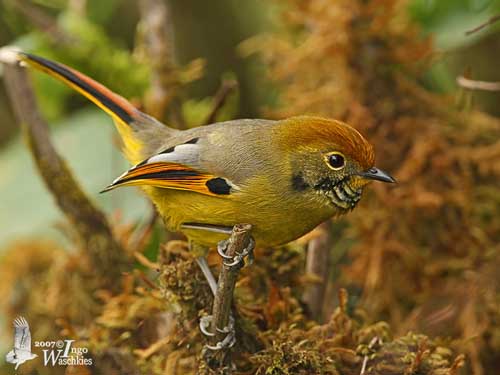
Fr: Minla à gorge striée
All : Bändersiva
Esp : Minla Colicastaña
Ital : Minla codacastana
Nd : Ornaatminla
Sd: Brunstjärtad minla
Photographer:
Ingo Waschkies
Bird Photography
Text by Nicole Bouglouan
Sources:
HANDBOOK OF THE BIRDS OF THE WORLD Vol 12 by Josep del Hoyo-Andrew Elliott-David Christie - Lynx Edicions - ISBN: 8496553423
A Field Guide to the Birds of South-East Asia by Craig Robson. New Holland Publishers. ISBN: 9781780090498
BirdLife International (BirdLife International)
XENO-CANTO – Sharing Birds sounds from around the world
Bar-throated Minla
Actinodura strigula
Passériforme Order – Leiothrichidae Family
BIOMETRICS:
Length: 16-18,5 cm
Weight: 14-24 gr
DESCRIPTION:
The Bar-throated Minla is a bird of the broadleaved evergreen forests of SE Asia.
The adult is a small grey to yellow bird. The upperparts are olive-grey. On the upperwing, the primary coverts are black, and contrast with the orange-yellow and black flight feathers’ edges and the broadly whitish edged tertials. The tail is brownish-chestnut and black, with broad white outer tips and yellow fringe.
The underparts are yellowish. The chin is yellow. The throat is whitish with narrow wavy black bars.
On the head, the crown is yellowish-rufous. We can see a short, narrow, dusky supercilium. Lores and ear-coverts are blackish washed yellow. A black submoustachial stripe extends under the ear-coverts.
The pointed bill is dark brown to blackish with paler lower mandible. The eyes are brown to reddish, surrounded by pale yellowish eye-ring. Legs and feet are grey to bluish-grey.
Both sexes are similar.

The juvenile has greyer upperparts than adult, and paler and duller underparts. The black throat bars are narrower and less distinct.
We can find six subspecies:
M.s. strigula occurs in WC Nepal E to Bhutan and NE India and adjacent S China.
M.s. simlaensis is found in N India E to W Nepal. Only the basal half of the tail is chestnut.
M.s. yunnanensis occurs in NE India, adjacent S China, Myanmar, N and C Laos and N Vietnam. It is more slate-olive above, with yellower crown and belly and darker chestnut on tail.
M.s. castanicauda is found in SE Myanmar and NW and W Thailand. It is similar to previous with blacker ear-coverts and paler, duller chestnut on tail.
M.s. malayana from Peninsular Malaysia. It has more slate-grey ear-coverts and greyish-olive wash on breast and flanks.
M.s. traii occurs in C Vietnam. It has more whitish lores, cheeks and upper ear-coverts, brighter crown and greyer underparts.
VOICE: SOUNDS BY XENO-CANTO
The Bar-throated Minla has sweet, clear, rising song, a high-pitched, slightly quavering “tui-twi ti-tu”, or “twi-ti-u”, or “twi-twi twi twi”.
It gives some calls, a sharp “kip”, a softer, nasal “yeep”, then upwards buzz and louder trilling buzz alternating with song phrases.
HABITAT:
The Bar-throated Minla frequents several types of evergreen forests such as oak, mixed deciduous-conifer forest, sometimes pine forest or pine-rhododendron, also open forest of birch or willow, bushes in forest, scrub and low bushes.
This species may occur from 1800 up to 3700 metres of elevation, lower during harsh winters in Indian Subcontinent.
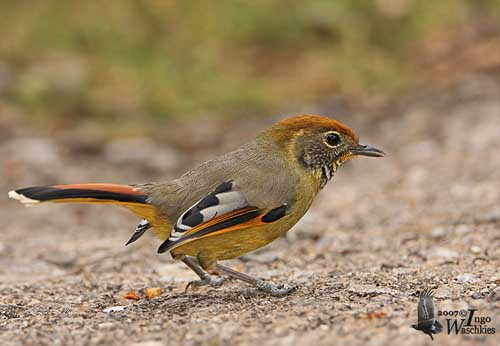
RANGE:
See above in “subspecies”
BEHAVIOUR:
The Bar-throated Minla feeds on insects and caterpillars, berries and seeds, and also nectar from rhododendron flowers. It feeds exclusively on insects during summer.
This is an arboreal species feeding as well at treetops as in low grassland. It can be seen in small groups of 6-20 birds outside the breeding season and may join other bird flocks.
The Bar-throated Minla is resident in its range, and only performs some local, seasonal and altitudinal movements.
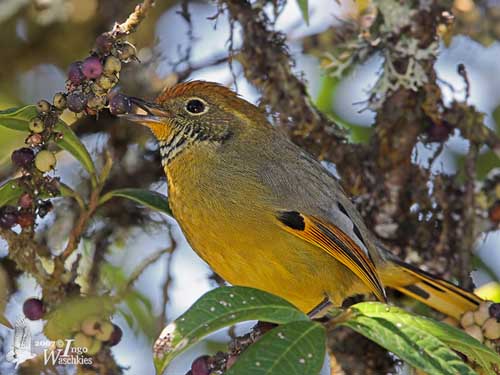
FLIGHT:
As arboreal species, the Bar-throated Minla performs short flights when foraging in the forest canopy.
REPRODUCTION:
The breeding season occurs from March to August.
The nest is placed between 1, 50 and 3 metres above the ground in bush or small tree. It is a neat cup-shaped nest made with grass, bamboo leaves, roots, birch bark and lichens. It is lined with hair, rootlets, pine needles and fern stalks.
The female lays 2-4 pale blue, deep blue or turquoise eggs with fine black, pale red or brown markings.
There is no more available information.
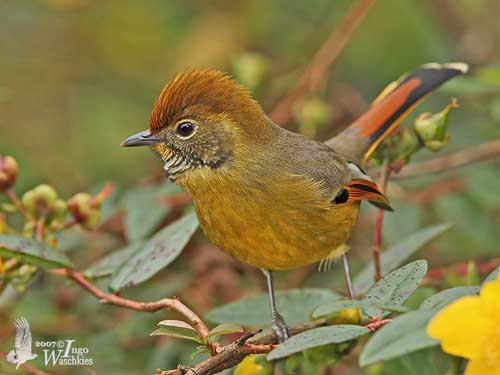
DIET:
The Bar-throated Minla feeds on Coleopterans, caterpillars and other insects species. It also consumes berries and seeds such as those of Baeckea frutescens, a small myrtaceous tree. It also takes nectar from rhododendron flowers.
PROTECTION / THREATS / STATUS:
The Bar-throated Minla is common in most parts of the range and this species in not currently threatened.
